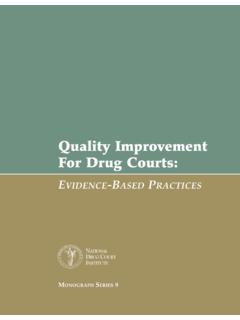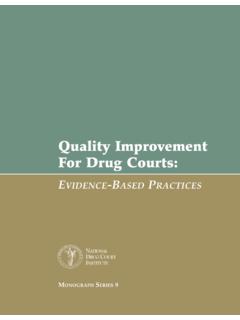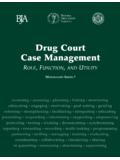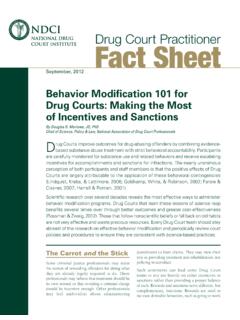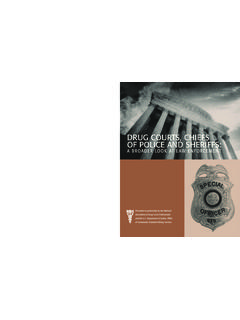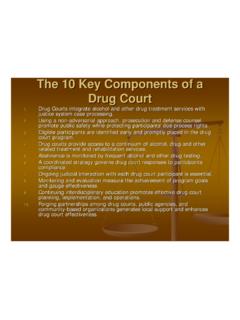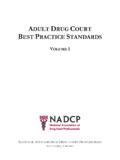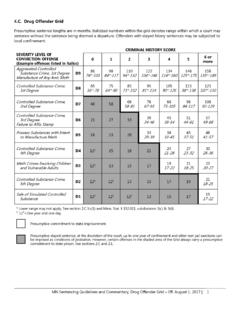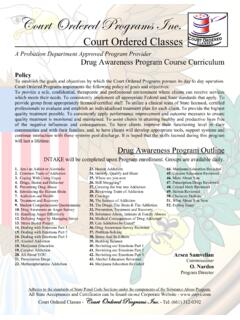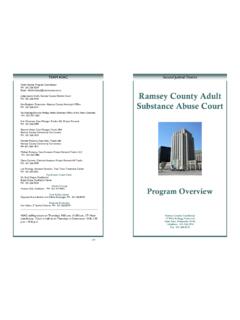Transcription of E T DRUG COURT U PRACTITIONER I - NDCI.org
1 NATIONALDRUGCOURTINSTITUTEKARENFREEMAN-W ILSON, EXECUTIVEDIRECTORAPRIL2006 VOL. IV, NO. 2 PREFACEThe duration of the urinary cannabinoid detection window is not settledscience. The number of days, following the cessation of marijuana smoking, necessary for cannabinoids to become non-detectable usingtraditional drug testing methods is the subject of debate among forensictoxicologists and a matter of on-going scientific research. This articlemakes no pretense to limit this important discussion, but rather, seeksto enhance it. It is hoped that drug COURT practitioners will find that thisinformation clarifies some of the complex issues associated with theelimination of marijuana from the human body.
2 Conventional wisdom has led to the common assumption that cannabinoidswill remain detectable in urine for 30 days or longer following the use of marijuana . These prolonged cannabinoid elimination projections havelikely resulted in the delay of therapeutic intervention, thwarted the timely use of judicial sanctioning, and fostered the denial of marijuanausage by drug COURT participants. This review challenges some of the research upon which the 30-plus dayelimination assumption is based. Careful scrutiny of these studies shouldnot be interpreted as an effort to discredit the findings or the authors of this research. However, as our knowledge evolves, the relevancy ofpreviously published scientific data should be evaluated anew.
3 One factis clear more research is needed in the area cannabinoid : DETERMININGTHELENGTHOFTIMECANNABINOIDSWI LLREMAINDETECTABLE INURINEFOLLOWINGSMOKINGA CRITICALREVIEW OFRELEVANTRESEARCH ANDCANNABINOIDDETECTIONGUIDANCEFORDRUGCO URTSBy Paul L. Cary, SHEETM erely attempting to formulate cannabinoiddetection guidance invites controversy. Somewill argue that the proposed detection windowdefined in this article is too short. Others willsuggest the opposite. Still others will insistthat the scientific evidence is insufficient toallow the establishment of such guidance. To some degree, each position has merit. Nodetection window guidance, regardless of theextent of scientific support, will encompassevery set of circumstances or all client nothing else, the research demonstrates thatthere is significant variability between individualsin the time required to eliminate drugs.
4 These facts, however, should not precludethe development of reasonable and pragmaticguidance, supported by scientific research, foruse in the majority of drug COURT is widely accepted that in order to instillsuccessful behavioral changes in a substanceabusing population, that consequences needto be applied soon after the identification ofrenewed or continued drug use. In a drug courtcontext, the application of judicial sanctionsand the initiation of therapeutic interventionshave been needlessly delayed due to a lack of coherent guidance regarding the length oftime cannabinoids will likely remain detectablein urine following the cessation of marijuanasmoking.
5 The purpose of this article is to provide that much needed a recent forensic publication, Dr. MarilynHuestis wrote: Monitoring acute cannabisusage with a commercial cannabinoidimmunoassay with a 50-ng/mL cutoff concen-tration provides only a narrow window ofdetection of 1 2 days, (2002). In a 1985 article by Ellis et. al., researchers concluded; that under very strictly supervised absti-nence, chronic users can have positive resultsfor cannabinoids in urine at 20 ng/mL orabove on the assay1for as manyas 46 consecutive days from admission, andcan take as many as 77 days to drop belowthe cutoff calibrator for ten consecutive days. Based upon these seemingly divergent findings,it is not difficult to comprehend why judges,attorneys and other drug COURT professionalsare in a quandary regarding the length of timemarijuana can remain detectable in urine following use.
6 The dilemma if the scientificresearch seems not to be able to achieve consensus on the urinary cannabinoid detectionwindow, how are those responsible for courtmandated drug supervision programs supposeto understand and resolve this issue?Like many other scientific and technical topicsthat have been thrust into the judicial environ-ment, the detection window of marijuana is both complex and controversial, yet theunderstanding of the pharmacology of thispopular substance is crucial to the adjudicationof cases in which marijuana usage is the difficulties associated with estab-lishing the length of time a drug will continueto test positive in urine after use are not uniqueto marijuana , the problem is exacerbated bythe extended elimination characteristics ofcannabinoids relative to other drugs of abuse.
7 Most notably after chronic questions posed by drug COURT professionalsrelated to cannabinoid detection in urine include: How many days is it likely to take for a chronicmarijuana user to reach a negative urine drugtest result? How long can cannabinoids be excreted anddetected in urine after a single exposure tomarijuana? How many days of positive urine drug tests for cannabinoids constitutes continued marijuana usage? How often should a client s urine be tested to monitor for continued abstinence frommarijuana? How many days should the COURT wait beforeretesting a client after a positive urine drugtest for cannabinoids has been obtained? How should the COURT interpret a positiveurine drug test for cannabinoids after a clienthas completed an initial 30-day detoxificationperiod designed to clean out their system?
8 NATIONALDRU GCOURTINSTITUTE2To one degree or another, answering thesequestions depends upon the ability of the courtto estimate the length of time cannabinoidswill likely remain detectable in urine followingthe use of marijuana by a drug COURT , the cannabinoid detection windowbecomes a determinative factor in the appro-priate interpretation of urine drug testingresults for marijuana . The lack of adequateguidance has hindered the development ofthese standards for use in drug is important to note that while courts may be seeking absolute answers (an exactcannabinoid detection window), the scienceof drug detection in urine can only providereasonable best estimates.
9 The law is notalways black and white; neither is , precise yes/no answers or exact detection windows are generally notattainable. Sensible guidance for the interpre-tation of urine cannabinoid results by drugcourts, however, is put, the detection windowis the lengthof time in days following the last substanceusage that sequentially collected urine sampleswill continue to produce positive drug testresults in other words, the number of daysuntil last positive sample. Thistime period isnotthe same as the length of time a drug willremain in someone s system that concept is, in reality, indeterminable (given that thereis no analytical method capable of detectingthe presence of a single molecule of drug in adonor s body).
10 The question being addressedherein is not how long minute traces of mari-juana will remain in a client s tissues or fluidsafter smoking, but rather how long thoseresidual cannabinoid metabolites will continueto be excreted in urine in sufficient quantitiesto produce a positive drug test (by standardscreening and confirmation testing).For those compounds with uncomplicatedmetabolic pathways or for those drugs thatare not significantly retained in body storagecompartments, detection times have beenestablished and generally accepted. Theseinclude urinary detection windows for drugssuch as cocaine (1-3 days), amphetaminesand opiates (1-4 days), and PCP (1-6 days)(Baselt, 2004).
